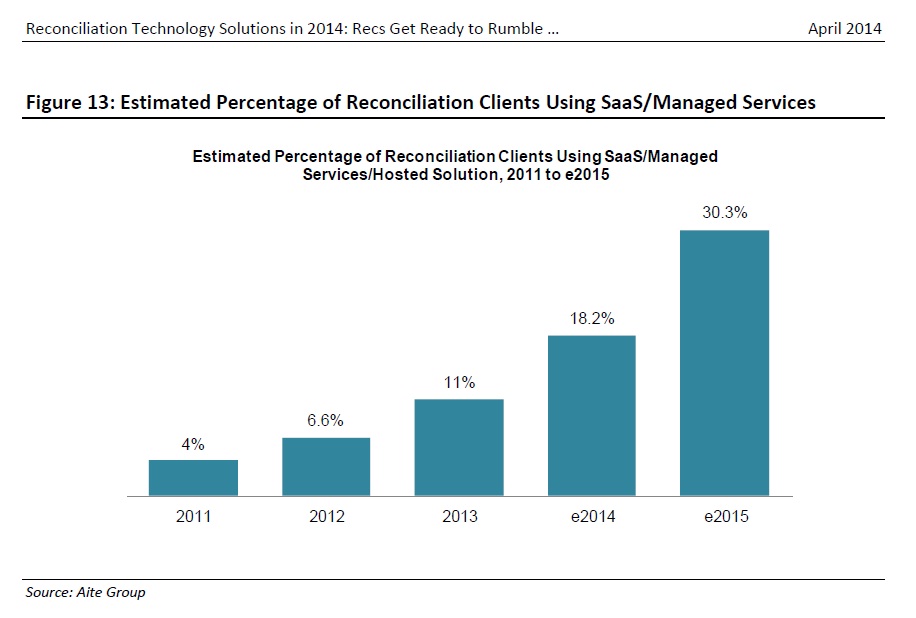Market pressures force tech rethink on reconciliation
Global regulatory pressure and the shift to real-time processing are causing banks and major financial institutions to rethink how they handle reconciliation, according to a new report by financial research house Aite.
The paper, Reconciliation Technology Solutions in 2014, suggests that continued emphasis on driving down internal costs at major global financial institutions since 2008 has led to a migration away from in-house deployment of reconciliation technology toward Software as a Service or hosted solutions. The percentage of reconciliation technology customers using hosted solutions increased from 4% in 2011 to 11% in 2013, and Aite Group expects it to reach 30% by the end of 2015. But Aite also warns that this trend may result in a conflict between operations teams and the advocates of outsourcing in the not too distant future.
The research also points out that firms should not expect to be able to simply outsource business problems. For example, opting for a fully hosted or managed service will not eliminate underlying problems in the business itself. Aite suggests that service level agreements should be combined with careful metrics to ensure that an agreement achieves success.
Desirable aspects of a reconciliation platform identified by market participants include:
- A flexible and intuitive user interface. Widespread headcount cutting over the last few years has led firms to consider the ease with which new solutions can be learned by employees
- The option for a thin-client application layer, which is important for firms seeking an easily configured interface that has a small technology ‘footprint’
- Real-time or near-real time processing support have become more important as reconciliation technology expands beyond books and records to support cash management, risk management and trading. This process has been given added impetus by the move across Europe to shorten the settlement cycle from T+3 to T+2 later this year.
- Support for nonstandard or unstructured data items has become more important as regulators have increased their oversight of markets such as OTC derivatives, where contracts may be sent via email or PDF
- Strong support for workflow and modelling is very important for users due to the rising focus on operational risk management
- Strong reporting and audit trail abilities have been highlighted as a must, given increasing focus on insider trading and market abuse regulations
- Greater support for a broad range of reconciliation types, including asynchronous matching and matching data at multiple levels
- Dashboarding abilities, which could enable financial institutions to better prove they are properly managing their operational risk
Problem areas identified by market participants include the time needed to onboard new clients and the limits of flexibility in the existing solutions. In response to increased demand, new market entrants have begun providing niche solutions for reconciliation.
“New technology developments and increased demand for reconciliation support resulting from regulatory requirements, combined with downward pressure on operational costs, have compelled firms to explore a broader range of technology solutions,” read the report. “Many firms have therefore begun to assess the wider universe of options in a bid to bring down ongoing expenditure, which in turn has inspired new product launches and the addition of different deployment options from incumbent household names.”
In total, the research estimates that global reconciliation spending will reach $1.13 billion by 2015. The need to invest in technology in this sector is driven by a number of factors including cost reduction, a push to centralise, increased market competition and business pressure to diversify into other asset classes. It is also driven by pressure to tackle fraud and market abuse, as well as by changing market infrastructure.
Rather than being exclusively applied to reconciling cash accounts, there is rising demand for reconciliation in other areas such as derivatives. The reconciliation industry is also growing because the number of criteria that clients expect the technology to meet is increasing. Workflow support is the most important demand, according to Aite, while flexibility has also become increasingly important due to the desire to extend reconciliation process support to more complex data sets.
Differing paths of global regulation have produced different effects on global reconciliation. The percentage of reconciliation clients has increased in Europe from 44% in 2011 to 45% in 2013, while it has fallen in North America from 37% in 2011 to 30% in 2013. The main reason is that Europe has regulation directly targeted at the buy-side, whereas the North American markets have seen comparatively less direct regulation, according to Aite. The report anticipates more growth in reconciliations in Europe in 2014 and 2015 as regulations such as EMIR continue to come into force.
The Aite paper was created following interviews with 23 financial institutions during Q3 and Q4 2013, including investment banks, asset managers, fund administrators, custodians, brokers and hedge funds.












































